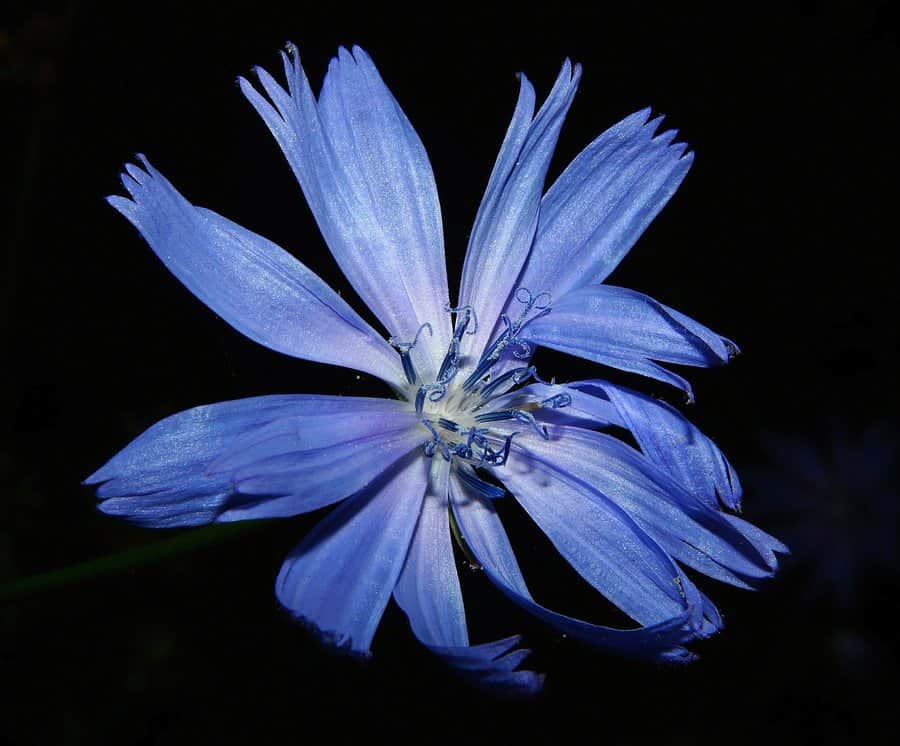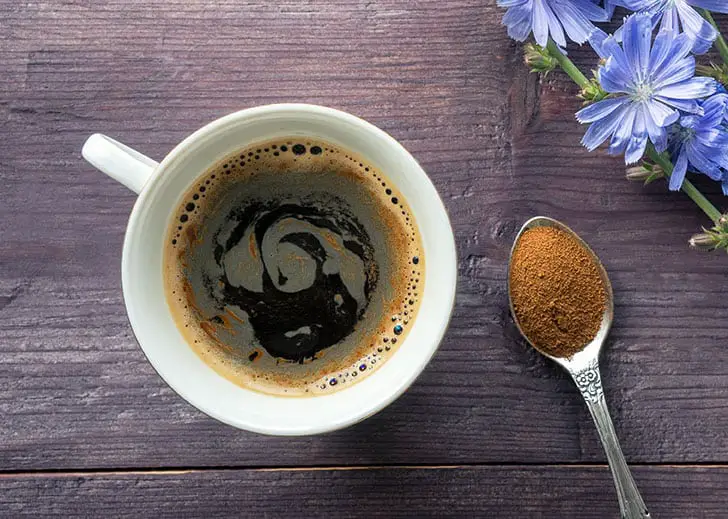
Chicory coffee is made from the roasted and ground roots of the chicory plant. It has a rich, slightly bitter flavoPicture this: you’re craving a bold, nutty cup of coffee, but without the caffeine jitters that keep you up all night. Enter chicory coffee—a roasted root beverage that’s been satisfying coffee lovers for centuries with its deep flavor and surprising health perks.
Whether you’re a coffee purist or just curious about new brews, chicory coffee might be your next obsession. Let’s explore what makes it special, from its fascinating history to how you can brew it at home.
What Is Chicory Coffee?

Chicory coffee is made from the roasted and ground roots of the chicory plant, a blue-flowered herb related to dandelions. Unlike coffee, which comes from beans, chicory is caffeine-free, offering a similar dark, slightly bitter taste that’s perfect for those who want the coffee experience without the buzz. The roots are harvested, dried, roasted, and ground into a powder that brews into a smooth, robust drink. Coffee drinkers love it for its versatility—enjoy it solo or blend it with coffee for a unique twist.
This plant isn’t just a one-trick pony. Its leaves are used in salads, and its roots have been prized for medicinal purposes since ancient times, making chicory a staple in both kitchens and apothecaries.
The History of Chicory Coffee
Chicory’s journey began over 5,000 years ago in ancient Egypt, where it was brewed as a medicinal drink to soothe ailments like digestive troubles and jaundice. By the 1600s, Europeans were growing it as a vegetable, tossing its bitter leaves into salads. The coffee connection sparked in France during the early 1800s, when Napoleon’s trade blockades caused coffee shortages. Roasted chicory roots stepped in as a substitute, delivering a coffee-like flavor at a fraction of the cost. Even after coffee returned, the French kept chicory in their blends for its rich taste.
The tradition crossed the Atlantic to New Orleans during the American Civil War, when Union blockades halted coffee imports. Locals mixed chicory with their dwindling coffee supplies, creating a bold brew that became a regional hallmark. Today, chicory coffee is enjoyed worldwide, from India to South Africa, as coffee drinkers rediscover its unique charm.
Why New Orleans Is Obsessed with Chicory Coffee

New Orleans isn’t just a coffee city—it’s the heart of chicory coffee culture. In the 1700s, French settlers brought coffee to the region, and by the 1840s, the city’s port was a major coffee hub. When the Civil War disrupted supplies, locals turned to chicory, blending it with coffee to stretch their rations. The result was a darker, nuttier brew that New Orleanians couldn’t get enough of, even after coffee became plentiful again.
At Café du Monde, a French Market icon since 1862, chicory coffee is served as café au lait—half coffee, half steamed milk—paired with powdered beignets. The creamy milk balances chicory’s slight bitterness, creating a comforting ritual that draws locals and tourists alike. For coffee drinkers, a visit to New Orleans isn’t complete without tasting this historic blend.
Health Benefits for Coffee Drinkers
Chicory coffee brings more to the table than just flavor—it’s packed with perks that appeal to health-conscious coffee lovers. Its key ingredient, inulin, is a prebiotic fiber that feeds beneficial gut bacteria, improving digestion and nutrient absorption. Research suggests inulin may also regulate blood sugar, making chicory a smart choice for those watching their levels. Antioxidants like phenolic acids help reduce inflammation, potentially lowering the risk of chronic conditions like heart disease.
Since it’s caffeine-free, chicory coffee is ideal for evening sipping without disrupting sleep, unlike regular coffee, which can keep you wired. Its high fiber content promotes fullness, supporting weight management—a bonus for those balancing coffee indulgences with wellness goals. However, chicory isn’t perfect for everyone. People with ragweed or pollen allergies may experience reactions, and overdoing it can cause bloating due to the fiber. Pregnant or breastfeeding folks should check with a doctor before diving in.
Chicory Coffee vs. Regular Coffee: How They Compare
To see why chicory coffee is gaining fans, let’s stack it up against traditional coffee. The table below highlights their differences, showing what makes chicory a compelling choice for coffee drinkers.
| Feature | Chicory Coffee | Regular Coffee |
|---|---|---|
| Source | Roasted chicory root | Roasted coffee beans |
| Caffeine Content | None | 80–100 mg per 8 oz cup |
| Key Nutrients | Inulin (fiber), antioxidants, calcium | Antioxidants, small amounts of magnesium |
| Flavor Profile | Nutty, slightly bitter, earthy | Varies (bold, acidic, or smooth) |
| Best For | Caffeine-free sipping, gut health | Morning energy, bold flavor |
This comparison underscores chicory’s role as a gentler alternative that still delivers a coffee-like experience, perfect for diversifying your brew routine.
Brewing Chicory Coffee Like a Pro
Brewing chicory coffee is straightforward, whether you’re a home barista or a casual sipper. Here are two easy methods to bring out its best flavors.
French Press Method: Combine 20 grams of coarsely ground coffee (a dark roast like Brazilian works well for its chocolatey notes) with 4 grams of ground chicory. Heat 300 grams of water to 205°F (or let boiled water cool for 30 seconds). Pour into your French press, stir, and steep for 4 minutes. Press the plunger slowly, pour, and enjoy. This method yields a bold, full-bodied cup that rivals any coffee shop brew.
Drip Coffee Maker: Mix 2 tablespoons of ground chicory with 4 tablespoons of coffee in your filter. Brew with 1 cup of water for a single serving. Want it caffeine-free? Use pure chicory—about 2 tablespoons per cup. Adjust the ratio to dial in your preferred strength. It’s a no-fuss option for busy mornings.
For a New Orleans-style café au lait, blend equal parts chicory coffee and steamed milk. The milk softens the bitterness, creating a creamy, indulgent drink. Try almond milk for a nutty, dairy-free spin that complements chicory’s earthiness.
Crafting Your Own Chicory Coffee

Feeling adventurous? Making chicory coffee from scratch lets you customize the flavor. Start with high-quality chicory roots from a health food store or online. Wash them thoroughly, chop into small pieces, and roast at 350°F for 45–60 minutes until dark and aromatic. Cool completely, then grind into a fine powder with a coffee grinder. Store in an airtight container in a cool, dry place. Use 2–4 tablespoons per cup of water, depending on how intense you like it.
This DIY process is like roasting your own coffee beans—a rewarding way to connect with your brew’s origins.
What Does Chicory Coffee Taste Like?
Chicory coffee delivers a rich, slightly bitter flavor with earthy, nutty notes. Lighter roasts may hint at sweetness, while darker ones lean into a bold, almost chocolatey depth. It’s smoother than many coffees, making it a cozy choice for slow mornings or chilly evenings. If the bitterness feels sharp, a dash of milk or a drizzle of honey can round it out, letting you tailor the taste to your liking.
Where to Get Chicory Coffee
You don’t need a trip to New Orleans to enjoy chicory coffee, though Café du Monde’s blend is a classic worth trying. Brands like Café du Monde, Community Coffee, and New Orleans Roast offer ground chicory-coffee blends online or in grocery stores. For pure chicory, check health food shops or Amazon. Many Southern cafés, especially in Louisiana, serve chicory brews, often as café au lait. If you’re after raw roots, farmers’ markets or organic suppliers are great sources.
Chicory Coffee’s Global Comeback
While New Orleans remains chicory’s epicenter, its appeal is spreading. In India, chicory is mixed into instant coffee and teas for a cost-effective, flavorful kick. South Africans sip it as a caffeine-free herbal drink, and Europeans still use it in salads or as a coffee enhancer. The wellness boom has fueled chicory’s rise, with its inulin content drawing health-conscious coffee drinkers. Market reports estimate the global chicory market could hit $905 million by 2026, driven by demand for natural, caffeine-free alternatives. For coffee lovers, it’s a fresh way to mix up the daily grind.
Wrapping Up
Chicory coffee is more than a stand-in for your usual brew—it’s a flavorful journey through history, health, and global coffee culture. Its nutty, caffeine-free profile and gut-friendly benefits make it a versatile addition to any coffee drinker’s lineup. Whether you’re brewing it at home, savoring it in New Orleans, or experimenting with blends, chicory coffee promises a bold, satisfying sip. So, why not shake things up? Grab some grounds, brew a cup, and see why this ancient root is winning over modern palates.

